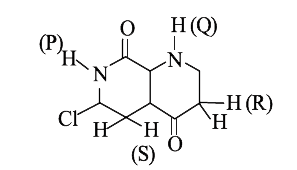What fraction of an indicator Hin is in the basic form at a pH of 6 if pKa of the indicator is 5?
12
111
1011
110
The correct Answer is:C
To find the fraction of the indicator Hin that is in the basic form at a pH of 6, given that the pKa of the indicator is 5, we can use the Henderson-Hasselbalch equation. Here’s a step-by-step solution:
Step 1: Understand the relationship between pH, pKa, and the concentrations of the forms of the indicator.
The Henderson-Hasselbalch equation is given by:
pH=pKa+log((A−)(HA))
where:
- (A−) is the concentration of the basic form (ionized form, Hin−)
- (HA) is the concentration of the acidic form (non-ionized form, Hin)
Step 2: Substitute the known values into the equation.
Given:
- pH=6
- pKa=5
Substituting these values into the equation:
6=5+log((Hin−)(Hin))
Step 3: Solve for the ratio of the concentrations.
Rearranging the equation gives:
6−5=log((Hin−)(Hin))
This simplifies to:
1=log((Hin−)(Hin))
To eliminate the logarithm, we exponentiate both sides:
101=(Hin−)(Hin)
This means:
(Hin−)(Hin)=10
Step 4: Determine the fraction of the indicator in the basic form.
Let (Hin)=x and (Hin−)=10x. The total concentration of the indicator is:
(Hin)+(Hin−)=x+10x=11x
The fraction of the indicator in the basic form is:
Fraction in basic form=(Hin−)(Hin)+(Hin−)=10x11x=1011
Final Answer:
The fraction of the indicator Hin that is in the basic form at a pH of 6 is 1011.
---
The Henderson-Hasselbalch equation is given by:
- (A−) is the concentration of the basic form (ionized form, Hin−)
- (HA) is the concentration of the acidic form (non-ionized form, Hin)
Given:
- pH=6
- pKa=5
Rearranging the equation gives:
Let (Hin)=x and (Hin−)=10x. The total concentration of the indicator is:
The fraction of the indicator Hin that is in the basic form at a pH of 6 is 1011.
Similar Questions
What fraction of an indicator Hin is the basic form at a pH of 5 if the pKa of the indicator is 6?
View SolutionThe pH indicators are
View SolutionWhat is the role of indicator in titration ?
View Solutionwhich of the indicated 'H' is most acidic ?

View SolutionAn acid-base indicator has a Ka of 3.0×10−5. The acid form of the indicator is red and the basic form is blue. (a) By how much must the pH change in order to change the indicator from 75% red to 75% blue?
View SolutionA certain acid-base indicator is red in acid solution and blue in basic medium. At pH=5 75% of the indictor is present in the solution in its blue form. Calculate the pH at which indicator shows 90% red form ?
View SolutionFor the indicator 'HIn' the ratio (IndΘ)/(HIn) is 7.0 at pH of 4.3. What is Keq for the indicator.
View SolutionThe Ka of an indicator HIn is 9 x 10−4, The percentage of the basic form of indicator is 10x in a solution of pH = 4. What is x ?
View SolutionAn acidic indicator ionises as InH⇔In−+H+ . The molecular and ions of the indicator show different colours. The indicator changed it colour if its acidic of basic form completely predominant.
Dissociation constant of an acidic indicator is 10−5 . At what pH 80% of the indicator exists in molecular form ?
View SolutionThe rapid change of pH near the stoichiometric point of an acid-base titration is the basic of indicator detection. pH of the solution is related to the ratio of the concentration of conjugate acid (H∈) and base (In−) forms of the indicator by the expression
View Solution
